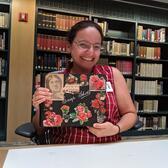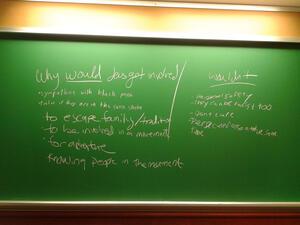Guess What's Being Taught in my Sunday School Class?
A few weeks ago, on the Sunday before Martin Luther King, Jr. Day, I posed a question to the students in my class on "Jews and the Civil Rights Movement": "If you could plan a Jewish commemoration for Martin Luther King, Jr. Day, what would it be? Who would be the audience? What would you do? Why should Jews, as Jews and in Jewish communities, commemorate this holiday?"
The class came toward the end of a semester that I had spent teaching—and learning from—JWA's Living the Legacy curriculum on Jews and the Civil Rights Movement with six devoted teenagers. We had by now spent hours talking about the different motivations Jews had for participating in the movement, the variety of ways that Jews were involved, the complicated relationship that Jews, and Jewish women in particular, had to powerful people in the movement, and the difference between acts of personal and collective resistance. We had listened to the music of the Civil Rights Movement and discussed what it would feel like as a Jew to be part of a communal experience of church-inspired music. We had read and debated Justice Justine Wise Polier’s ruling that experienced teachers should not be allowed to choose white classrooms thereby creating de facto educational inequality. We had discussed whether a student’s participation in Freedom Summer was any less noble if it was motivated primarily by a sense of adventure rather than by a commitment to social justice.
These were not simple conversations designed to congratulate Jews for the choices they had made.They were nuanced conversations that helped the students better understand today’s America and their place, as Jews, within it.
At the beginning of the semester, I asked my students what they knew about Jews and the Civil Rights Movement and why the class belonged in a Sunday School. They had no answers to either question. Most of the students had only a superficial knowledge of the Civil Rights Movement—Rosa Parks and the bus boycott, King's "I Have a Dream Speech," perhaps the Freedom Riders, the Civil Rights Act. None of them knew of Jews who had been involved in the Civil Rights Movement, and none of them had a sense that the Civil Rights Movement could be considered a topic in Jewish history. They had signed up for the course precisely because the subject matter was so surprising to them.
Now, toward the end of the semester, their answers to the question of Jewish commemoration of Martin Luther King, Jr. Day were varied and informed. Reading about a synagogue's MLK-themed Shabbat service, one student expressed concern that this one-time event would not create the kind of ties between communities that made the Civil Rights Movement itself so inspirational and so politically effective. He proposed a Jewish-African American dialogue group that would meet on a monthly basis to discuss political events and to engage in social justice work. Another student felt that the appropriate way to commemorate MLK Day within the Jewish community would be to organize a community-wide anti-war rally in honor of Martin Luther King, Jr.'s principles of non-violence. A third student proposed the creation of a documentary film that highlighted the variety of Jewish responses to and participation in the Civil Rights Movement, one that did not mythologize the past but presented it in its raw and contradictory form. A fourth student suggested that the best way to honor the legacy both of Martin Luther King, Jr. and of the Jews who participated in the movement would be to teach about that legacy beginning at a very young age.
In each of these responses, and in the conversations that followed, I learned something about what my students had gained from the Living the Legacy curriculum. They had learned about the tensions and tactics of grassroots social movements, about the importance of building communities, about, as one student described it, "contradictions within unity." They had learned that even within a cohesive movement, there were multiple goals, strategies, and perspectives.
They had also learned that the Jewish community in America did not simply follow a trajectory from shtetl to assimilation, that it did not develop in isolation from the rest of American society. Rather, they learned that Jews were active participants, and sometimes leading figures, in the same American history that they study in their "regular" schools.
The Living the Legacy curriculum helped my students understand that they can participate in broader American social and political activism as Jews, following a Jewish tradition. By labeling the Civil Rights Movement as part of Jewish history and by highlighting the varied Jewish experiences in the movement, Living the Legacy inspired my students to think about Jews as active agents of the American past and present and to see themselves as part of a tradition dedicated to improving the world (and not just the Jewish parts of the world).
As a teacher working with this material, I am inspired time and again by the bravery and audacity of the young men and women who risked their lives to reshape the world in which they lived, men and women not much older than the students I teach. I am amazed time and again by the diverse goals and strategies within the movement, and how the movement mobilized so many individuals and communities to work for change. And I am impressed time and again by my students—by their readiness to be inspired, by their searching for and finding Jewish role models in this history, and by their eagerness to grow together through grappling with material that is emotionally and intellectually challenging.
Personally, I can think of no better tribute to Martin Luther King, Jr., to the Civil Rights Movement, and to the Jews who supported it than to teach this history in an honest and rigorous way. I am grateful to have the Living the Legacy curriculum as a guide.
Living the Legacy was funded in part by the Covenant Foundation.








I hope Ms. Kirzane will similarly teach about Jews in the second wave of women's rights movement. I'll be happy to help her on this. I'm a cofunder of NOW and I was the first woman attorney in the Office of the General Counsel at the EEOC--and, of course, I'm Jewish.
In reply to <p>I hope Ms. Kirzane will by Sonia Pressman…
Thank you for this comment. I am currently teaching a course on "Great American Jewish Women" and would love to hear your suggestions for segments on second wave feminism. I will be in touch via e-mail.